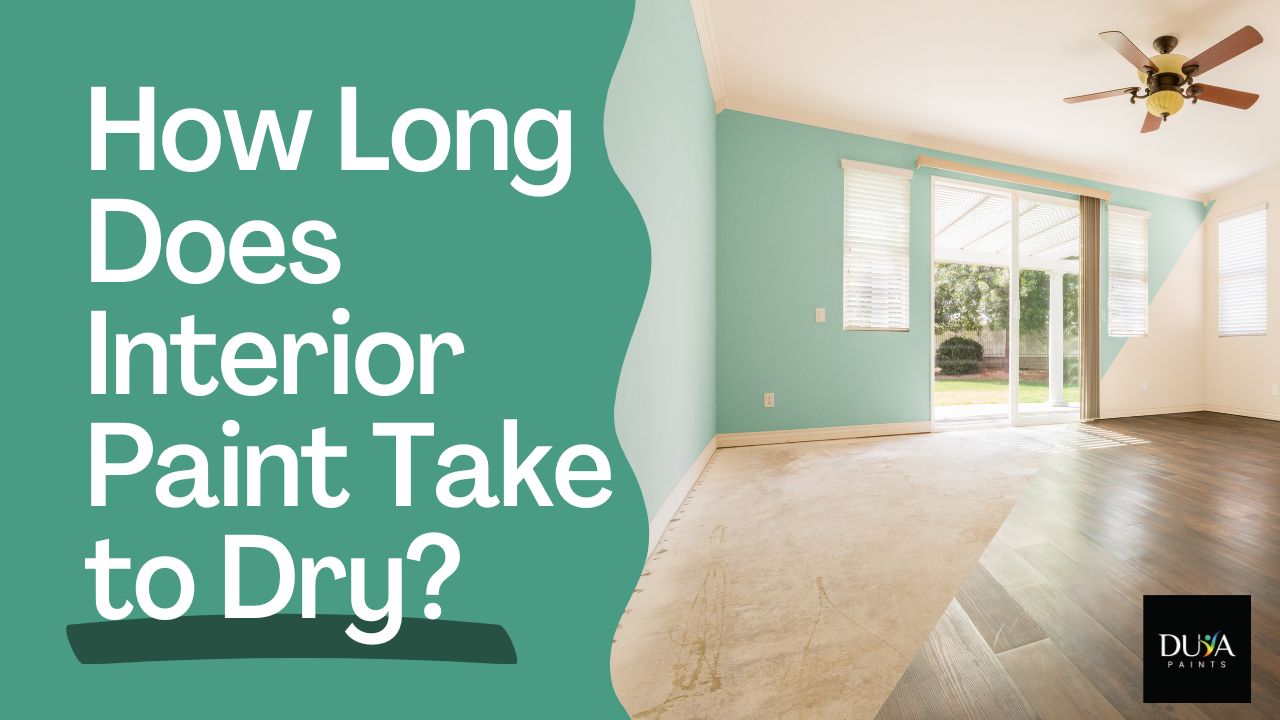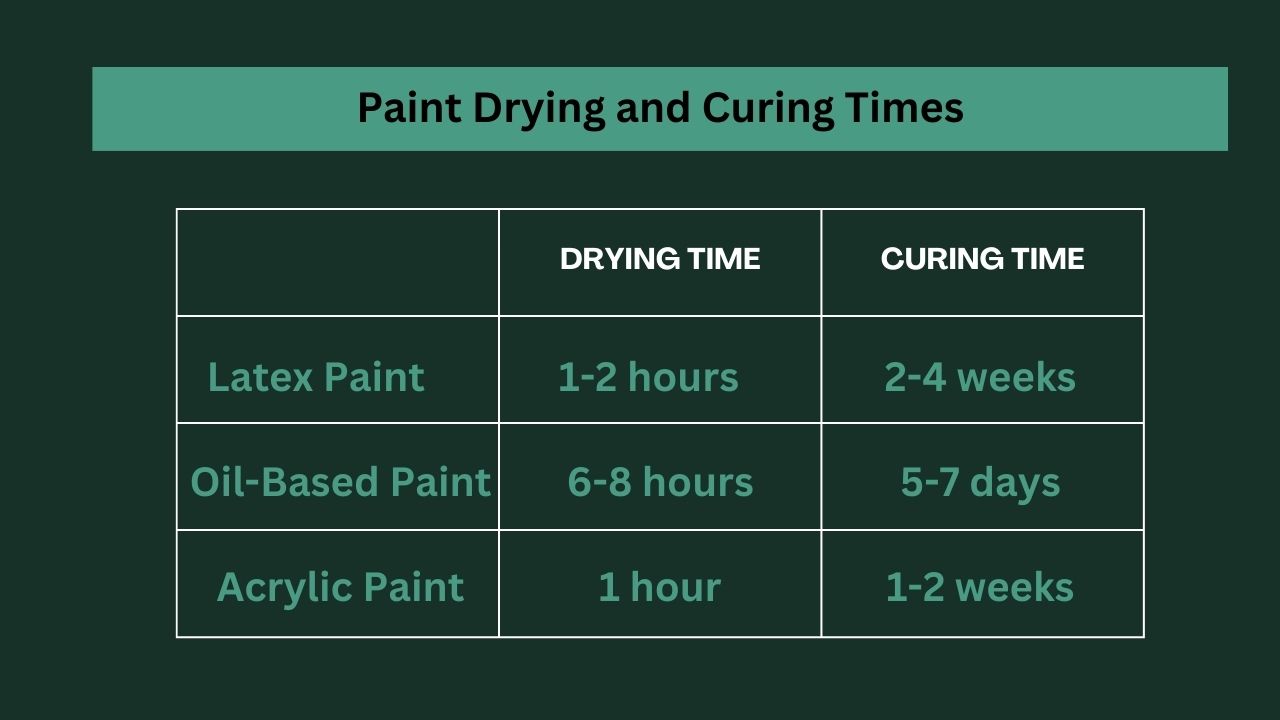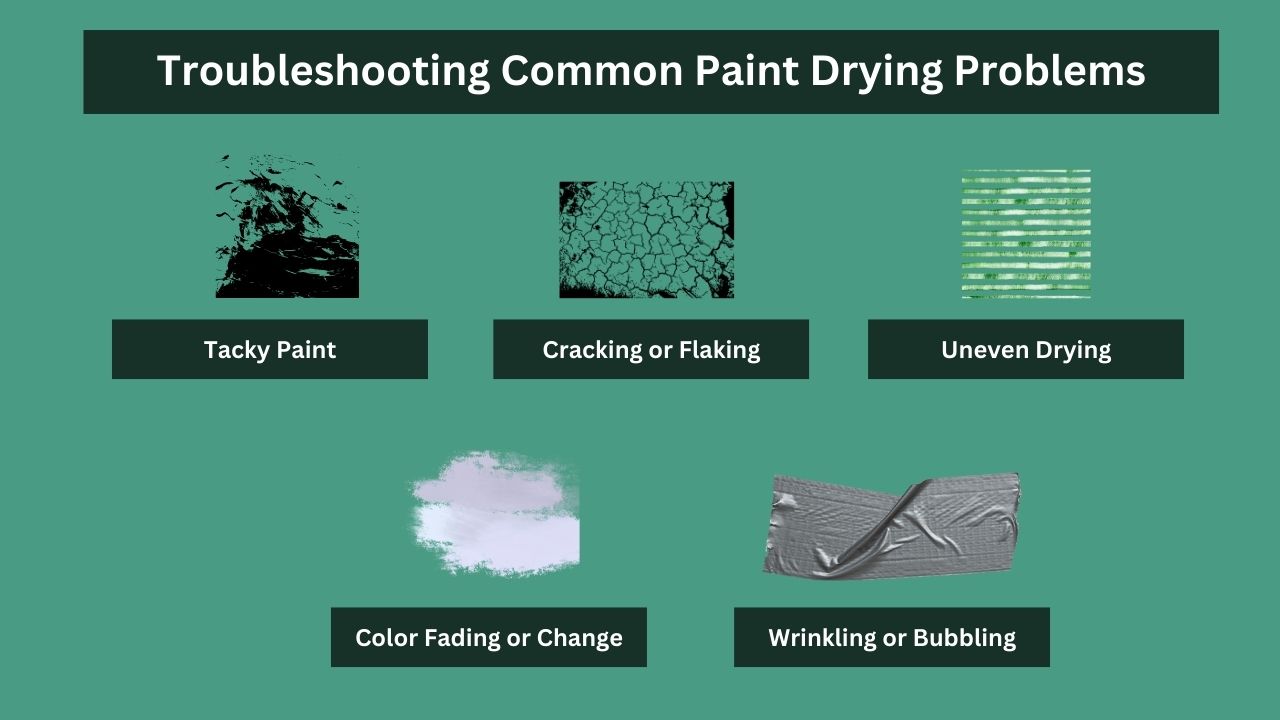How Long Does Interior Paint Take to Dry? Factors Affecting Drying time

When embarking on an interior painting project, understanding how long interior paint takes to dry can help you plan your project more effectively. This ensures a smooth, professional finish and helps avoid issues such as peeling, cracking, or smudging.
Interior paint drying times vary: latex dries in about 1 hour, recoatable in 4 hours; acrylic dries in 30 minutes, recoatable in 2 hours; oil-based dries in 6–8 hours, recoatable in 24 hours.
In this guide, we will provide detailed information about paint drying times, factors affecting these times, and the differences between drying and curing. We’ll also cover specific details for summer and winter conditions to help you plan your project accordingly.

Understanding Paint Drying and Curing Times
Interior paint drying times can vary significantly depending on the type of paint used, the thickness of the coats, and environmental factors. Here’s a breakdown of the general drying times for different types of paint:

Latex Paint
Latex paint is a popular choice for interior walls due to its ease of application, low odor, and relatively quick drying times. Latex paint can feel dry to the touch within 1-2 hours, but it’s recommended to wait 4-6 hours before applying another coat. Complete curing, where the paint reaches its maximum hardness and durability, can take 2-4 weeks.
Oil-Based Paint
Oil-based paints offer a hard, durable finish, making them suitable for high-wear areas like trim or furniture. However, they take significantly longer to dry. Oil-based paint can take 6-8 hours to become dry to the touch and requires 24 hours before applying a second coat. Complete curing can take 5-7 days.
Acrylic Paint
Acrylic paint is another excellent option for interior surfaces. It is known for its durability and smooth finish. It dries exceptionally fast, often drying to the touch in 30 minutes to 1 hour. You can typically recoat within 2-4 hours. However, like latex paint, complete curing can take 1-2 weeks.
Summer vs. Winter Drying Times
The time of year can significantly impact paint drying due to temperature and humidity variations.
Also Read: What is the Lifespan of Opened Interior Paint?
Summer Conditions
- In summer, higher temperatures can accelerate the drying process. However, if it’s excessively hot, the paint’s surface may dry too quickly, leading to cracking or an uneven finish.
- Ideal summer conditions for painting are temperatures between 20°C and 25°C with moderate humidity levels.
Winter Conditions
- In winter, lower temperatures can significantly slow down the drying process. Cold temperatures reduce the evaporation rate of the paint’s liquid components, resulting in longer drying and curing times.
- To combat this, ensure the room is well-ventilated and maintained at a temperature within the ideal range for the specific type of paint used.
Explore this Reddit thread on how long indoor house paint takes to dry. If you need more info, then it’s a helpful discussion for understanding drying times and tips.

Factors Affecting Paint Drying Times
Several factors can influence how quickly paint dries and cures. Understanding these can help you plan your painting project more effectively.

Humidity
High humidity levels slow down the evaporation of water from the paint, extending drying and curing times. Conversely, low Humidity can help paint dry faster. Using a dehumidifier in high humidity conditions can be beneficial.
Temperature
Temperature plays a critical role in paint drying times. Too high or too low temperatures can adversely affect the drying process. The optimal temperature range for most paints is between 20°C and 25°C.
Ventilation
Good ventilation helps to remove moisture from the painted surface, promoting faster drying. Ensure adequate Airflow by opening windows, using fans, or employing a dehumidifier, especially in humid or enclosed spaces.
Coat Thickness
Applying thinner coats of paint allows for faster drying and curing. Thicker coats take longer to dry, increasing the risk of imperfections such as drips or unevenness.

Type of Paint
Due to their composition, different types of paint have varying drying times. Latex and acrylic paints generally dry faster than oil-based paints.
Coalescing Solvents
Some water-based paints contain coalescing solvents that help form a strong film but can extend the curing time.
Check out WetCanvas to learn why certain pigments dry faster than others. It’s a great place to understand art techniques and materials.
- My Experience with Interior Painting
Having painted several rooms in different seasons, I’ve learned that timing and environmental control are essential for a successful paint job. During one particularly humid summer, I noticed the paint took much longer to dry, resulting in a few imperfections. I quickly realized the importance of using fans and dehumidifiers to speed up drying. Conversely, in winter, ensuring the room was adequately heated significantly changed drying times.
Drying vs. Curing: What’s the Difference?
Have you ever wondered about the difference between drying and curing paint? Here’s what I’ve learned:
- Drying
Drying is the initial stage in which the paint’s liquid components evaporate, primarily water or solvents. The paint film feels dry at this stage, but the curing process has yet to begin.
- Curing
Curing is a slower chemical process where the paint binders harden, forming a strong, resilient film. This process is crucial for the paint to reach its full performance capabilities, such as durability, scratch resistance, and washability. Curing can take significantly longer than drying and varies depending on the type of paint and environmental conditions.
What is Coalescence?
Coalescence involves paint particles merging, facilitated by binders that act like glue. This process solidifies the paint film, making it resistant to scratches, stains, and washing.
Importance of Allowing Paint to Cure Fully
Using a painted surface before it’s fully cured can lead to various issues:
- Risks of Incomplete Curing: Using a painted surface before it fully cures can lead to scratches, marks, or peeling. Fully cured paint offers superior resistance to wear and tear, moisture, and stains.
- Curing Times Variability: Curing times vary based on paint type, number of coats, and environmental conditions. Always refer to the manufacturer’s recommendations for specific drying and curing times.
Tips for Faster Drying
Let me share some tips I’ve learned from my six years of experience to help paint dry faster:
- Boost Airflow: I always use circulating fans and open windows to speed up evaporation. Good Airflow makes a big difference.
- Humidity Control: In humid climates, I recommend using a dehumidifier. It helps pull moisture from the air, which accelerates drying.
- Apply Thin Coats: Instead of one thick coat, applying several thin layers allows moisture to escape more quickly. It’s a simple trick that works wonders.
- Expert Advice: For the best results, I prefer painting early in the morning or evening when temperatures are cooler and more favorable. Dehumidifiers can really help in humid conditions.
Troubleshooting Common Paint Drying Problems

Tacky Paint
If your paint feels sticky longer than expected, a few things could be causing it:
- High Humidity: I’ve found that using a dehumidifier and improving airflow help. They reduce moisture in the air, which speeds up drying.
- Thick Coats: Sometimes, applying thick coats can slow down drying. Lightly sand the tacky area and apply thinner coats per the manufacturer’s instructions.
- Specific Paint Types: Always follow the instructions on the paint can. Different paints have different drying times and requirements.
Cracking or Flaking
If the paint develops cracks or starts to flake off, these factors may be at play:
- Poor Adhesion: Ensure the surface is adequately cleaned and prepared before painting. Lack of adhesion can cause paint to crack or peel.
- Extreme Temperature Fluctuations: Rapid temperature changes can stress the paint film, leading to cracking. Maintain a stable indoor environment during and after painting.
- Old or Improperly Stored Paint: Use fresh paint that has not been exposed to extreme temperatures or moisture. Old paint may not perform as expected.
Uneven Drying
If your paint dries unevenly, creating blotchy patches:
- Inconsistent Coat Thickness: Apply even, thin coats across the entire surface. This helps the paint dry uniformly.
- Variations in Surface Material: Using a primer can create a smooth, uniform base to which the paint can adhere.
- Drafts: Manage Airflow during drying to avoid strong drafts that can cause uneven drying.
Color Fading or Change
If the color of my paint fades or changes over time, these are the things I should think about:
- Quality Paint: It’s important to use good-quality paint that’s made to resist fading from sunlight and other things in the air.
- UV Protection: When I’m painting outside or in a sunny spot, look for paint that has stuff in it to keep the color from fading.
- Proper Way to Paint: Follow the directions for how to paint and how long to let it dry. Doing it correctly helps the paint keep its color and look good longer.
Wrinkling or Bubbling
When you notice wrinkles or bubbles in the paint:
- Allow Complete Curing: Let the paint fully cure before assessing. Sometimes, minor imperfections settle as the paint cures.
- Scrape, Sand, and Reapply: For more severe cases, gently scrape off the affected area, sand it smooth, and reapply thin coats of paint.
Hopefully, this article has answered all your questions. Now, let’s tackle FAQs quickly and efficiently.
Conclusion
Understanding interior paint’s drying times is crucial for a successful painting project. Whether using latex, acrylic, or oil-based paints, following recommended drying and recoating intervals ensures a smooth and durable finish. Considering factors like room temperature, Humidity, and paint type, you can optimize drying times and enjoy a beautifully painted space for years.

FAQs
How can I prevent brush marks from appearing on my walls?
Can I paint over the wallpaper, or do I need to remove it first?
What should I do if I accidentally get paint on my carpet or furniture?
How long should I wait before washing newly painted walls?
Is using a primer before painting necessary, or can I skip this step?
REFERENCES
- https://www.painttalk.com/threads/dry-time.94155/
- https://www.reddit.com/r/NoStupidQuestions/comments/qfz5a7/how_long_does_indoor_house_paint_take_to_dry/
- https://www.quora.com/How-long-does-house-paint-take-to-dry
- https://www.diychatroom.com/threads/how-long-does-it-take-acrylic-paint-to-dry-cure.639521/
- https://www.thedecoratorsforum.com/drying-process-of-water-based-paint/
